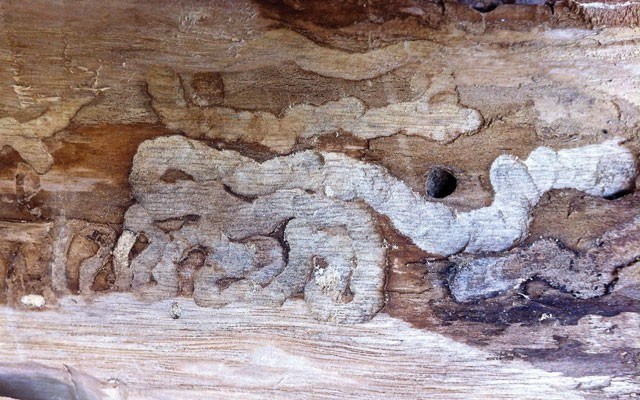For survey biologists working on non-native insect prevention like Vancouver-based Troy Kimoto of the Canadian Food Inspection Agency (CFIA), wood packaging remains the biggest concern — even if its ingress is concentrated in only a few major ports. Over 50 per cent of all foreign containers bound for Canada end up in the Greater Toronto Area, arriving there either directly or to docks in Vancouver (3,360 kilometres), Halifax (1,800 km), or Montreal (550 km) to be subsequently shipped by train or truck. With such vast distances involved, additional worry surrounds the opportunity for non-native insect introductions to occur along transport routes — or in remote endpoints.
"Look at all the heavy equipment from overseas being shipped to the Alberta tar sands," says Kimoto. "The Canadian Border Services Agency is responsible for inspecting that stuff but it can only do so much. Even if it doubled human resources, that would only mean increasing inspections from one to two per cent of shipments to two to four per cent."
(In a telling demonstration of how much slips through without the capacity for rigorous screening, a 20-week trial of comprehensive air cargo inspections at Maui's Airport by the Hawaii Department of Agriculture in 2001 turned up 279 insect species, 125 previously unrecorded there, and 47 different plant pathogens, including 16 novelties.)
Concerns in ports like Seattle and Vancouver, however, aren't confined to unloaded items. For instance, attracted to their lights, the Asian gypsy moth lays eggs on ships docked in its native range that subsequently cross the Pacific. While the ships wait here to unload, eggs hatch and the tiny larvae shoot out a thread that sees them picked up by the wind and blown ashore. With things like this for the CFIA to keep track of, it makes sense to enlist the public's help.
"Canada is a huge country and we obviously can't put out traps everywhere," says Kimoto. "So we're doing more outreach. We have a set of waterproof 'Insects Not Wanted in Canada' cards we give to foresters, orchard pest control people, and arborists. We've even made removable tattoos of non-native forest pests for kids."
Engaging tools, but pushing out the prevention gestalt remains a game of manpower: for every CFIA employee addressing invasives, the USDA and other stateside agencies have 12 to 15 bodies working on the same things, many dedicated specifically to outreach. Given such thin frontlines in this country, what of imminent threats — like the hemlock woolly adelgid that has virtually wiped out Eastern Hemlock along the U.S. eastern seaboard since being introduced from Japan in the early 1950s? "It's been in B.C. for some time but doesn't really affect western hemlock," says Kimoto. "We've only seen it in a couple urban areas, and it doesn't cause the kind of mortality it does in the East."
The nano-sized adelgid, in fact, doesn't fly, moves slowly, and is difficult to find, its presence most often revealed by cottony egg sacs resembling a tiny Q-tip (hence "woolly"). Kimoto has a buddy in the Canadian Forest Service (responsible for established insect pests) who spends his time brainstorming novel ways to locate adelgids. One of these involves using a slingshot to propel a series of 10 racquetballs swathed in Velcro into the crown of a hemlock, targeting different aspects and different heights to catch egg sacs (tests on a known infestation in New York state showed that 10 balls usually detected even the smallest population).
Kimoto is also keeping an eye out for the red-necked longhorn beetle, a continental pal of the villainous Asian long-horned beetle. Intercepted in packaging in both the U.K. and Seattle, it's known to have established in a cherry tree in Germany and two different orchards in Italy where it's killing off plum and peach. Gaining foothold in North America would be oh-so-bad for the fruit-growing central valleys of both B.C. and Washington state, or Ontario's Niagara Peninsula. Perhaps worse for the likes of Squamish, Whistler and Pemberton, the beetle has a fondness for the genus Populus — aspens, poplars, and cottonwoods — trees which, in addition to being natural colonizers, are both adventitious and purposely planted on all human-occupied landscapes. The presence of such a variety and abundance of potential hosts effectively lowers the threshold for establishment, meaning fewer introductions of the beetle would be required for this to occur.
Kimoto wrapped our talk about non-native insect threats with a hopeful screed on various research initiatives and international collaborations, of which I caught only snippets... like using Slovakia as the model for jewel-beetle detection in Central Europe... or new Chinese research that involved electrodes inserted in beetle antennae to register which chemicals were attractive or repellent. "Maybe in 10 years or so we'll have the tools to detect jewel beetles," he finished.
That drove home an important point: while the ever-inventive Homo sapiens that once crossed the Bering Strait to occupy this coast excels in applying post-hoc solutions like Velcro-covered racquetballs to its self-inflicted biological problems, invasive insect species have forced us into playing the longer game — historically our worst skill.
For the first part of this series, check the May 19th edition of Pique.
Leslie Anthony is a Whistler-based author, editor, biologist and bon vivant who has never met a mountain he didn't like.




